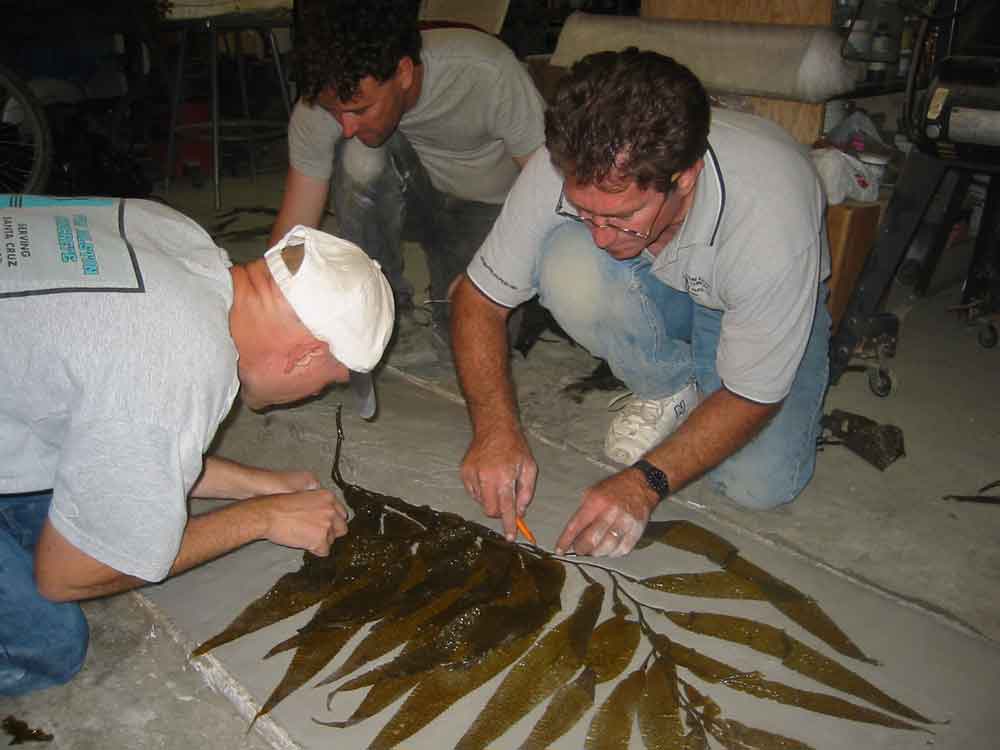Blog
- Details
- Written by: Tom Ralston
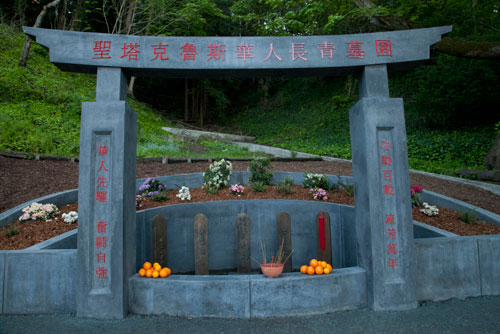 Tom Ralston Concrete has built quite a few very cool and interesting concrete and masonry pieces for Santa Cruz County. However I could make a strong case that to date the Chinese Monument that TRC built in 2014 in the Santa Cruz Evergreen Memorial is the most meaningful and significant.
Tom Ralston Concrete has built quite a few very cool and interesting concrete and masonry pieces for Santa Cruz County. However I could make a strong case that to date the Chinese Monument that TRC built in 2014 in the Santa Cruz Evergreen Memorial is the most meaningful and significant.
There were many that contributed to the idea, the vision, and to the construction of the Chinese Memorial. The George and Emily Ow Family primarily funded the project. The Museum of Art and History helped to generate momentum and was led by Director Nina Simon. Nina's husband Sibley diligently worked with volunteers and organized labor to help pull the project together. The initial monument concept and inspiration was from Geoffrey Dunn and George Ow who met with me to begin brainstorming ideas for the memorial.
The Chinese that were buried in the Evergreen Memorial were immigrants that came to California and Santa Cruz to escape rebellion and civil war; but also to fulfill a dream of prosperity and to make a better life for their families. To paraphrase historian Sandy Lydon: the contributions that the Chinese made were fundamental to the region's economic development they were not treated as such. As history tells us many if not most of the Chinese settlers were treated like second rate citizens there are ample examples of gross prejudice.
Again from Lydon in his book Chinese Gold "No Monuments, no prominent place names, no gilt "Chinese-style" buildings, and no large concentrations of Chinese people attest to the presence [and contributions made] in the Monterey Bay Region."
Now, with the Chinese memorial built in the Evergreen Cemetery, there finally is a place that people can honor and memorialize the Chinese settlers. Last year on April 5, 2014 the Santa Cruz Museum of Art and History organized a funeral procession that started on Front Street near Old Chinatown and ended in the Chinese section of the Evergreen Cemetery. Along the way the procession was joined by Chinese "lion dancers" who provided a very colorful addition to the Chinese celebration.
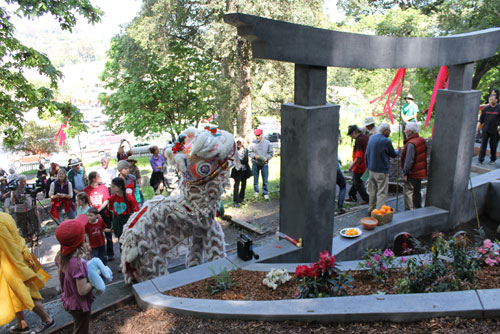
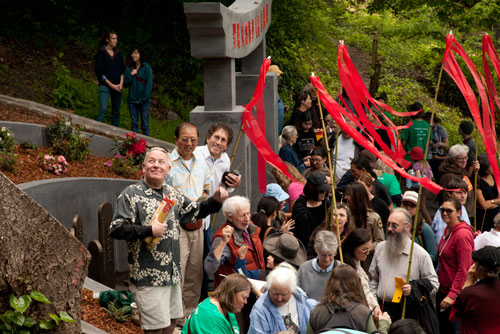
My vision for the concrete memorial was carried out by TRC's dedicated and hardworking crews and were led by master carpenter Rex Nicoliason. The structure, which was all poured together with a special colored SCC (self-consolidating concrete), when fully cured will be in excess of 8,000 PSI. Regular concrete starts at about 2500 PSI. Sean Monaghan who has partnered with me on many creative projects over the last 2-decades cast some incredible solid bronze headstones that had names of Chinese actually buried in Evergreen. The headstones were originally made with simple wooden 2 x 12's 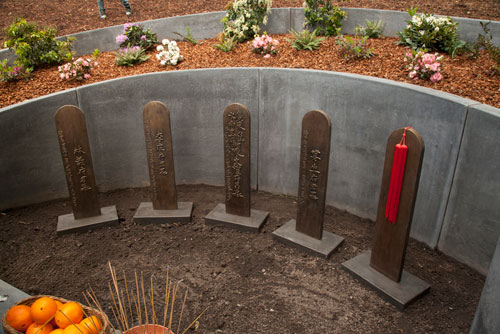 which had the deceased names carved into them. Sean beautifully replicated the wooden headstones with bronze and had his student, Yue Yu, provide the translation and calligraphy for the headstones. Ralph Royer and Josh Roton of RCR fabrication made exacting Chinese characters that were later powder coated a brilliant red. The red characters played beautifully off of the charcoal colored concrete. The translation and poetry for the monument was provided by Professor Yuming Shang. Other local contractors that contributed to making this happen was Landscape Contractor Randy Quilici, Lewis Tree Service, E Clampus Vitus Branciforte Chapter 1797, The Landscape Company, Homeless Services Center, Y.E.S. High School and many other volunteers.
which had the deceased names carved into them. Sean beautifully replicated the wooden headstones with bronze and had his student, Yue Yu, provide the translation and calligraphy for the headstones. Ralph Royer and Josh Roton of RCR fabrication made exacting Chinese characters that were later powder coated a brilliant red. The red characters played beautifully off of the charcoal colored concrete. The translation and poetry for the monument was provided by Professor Yuming Shang. Other local contractors that contributed to making this happen was Landscape Contractor Randy Quilici, Lewis Tree Service, E Clampus Vitus Branciforte Chapter 1797, The Landscape Company, Homeless Services Center, Y.E.S. High School and many other volunteers.
Sibley Simon who is the chairman for the Evergreen Cemetery committee for the MAH took the lead for overseeing construction and making sure that the Cemetery was cleaned up and ready to go for the Quing Ming Festival or "Tomb Sweeping Day". According to George Ow in Chinese folklore, "if something is not settled during a lifetime, you have hungry ghosts, like angry spirits." Barring a nuclear warhead striking the memorial with a direct hit the structure will stand for thousands and thousands of years, forever feeding and pacifying the hungry ghosts.
I will be forever grateful for being asked to create such an important and significant monument. My thanks go to all!
Tom Ralston
- Details
- Written by: Tom Ralston Concrete
 Located just next to the Santa Cruz harbor, this lovely home is the result of tedious and masterful decorative concrete work.
Located just next to the Santa Cruz harbor, this lovely home is the result of tedious and masterful decorative concrete work.
The Tom Ralston Concrete team was responsible for making this dream home a reality. Directly in the middle of the home there is a massive column with inset anchors that support a spiralling staircase. TRC molded and poured the 30 inch solid concrete column which spans all three stories of the home.
Marilyn Crenshaw, a.k.a The Green Architect designed the railing that caps off this functional and beautiful set of stairs. The railing is made of stainless steel, and is reminiscent of something you would find on a boat down in the harbor.
 The different levels of the home have different blends of color hardeners - colors like oyster shell and golden sandstone. One level of the concrete floor was hit with an acid wash, followed by an antique amber acid stain - beautiful colors that exist naturally along this idyllic coastal California setting.
The different levels of the home have different blends of color hardeners - colors like oyster shell and golden sandstone. One level of the concrete floor was hit with an acid wash, followed by an antique amber acid stain - beautiful colors that exist naturally along this idyllic coastal California setting.
All in all, Tom Ralston Concrete is happy to share unique projects crafted from his years of experience in the decorative concrete industry. Check out his Master Q&A for expert advice and insight.
Stay tuned for next month's featured project. Check out more of Tom Ralston's work here. Have any questions or comments? Feel free to contact us.
You can stay updated with the latest from Tom Ralston Concrete by following us on, Facebook, Instagram, Linkedin, or Houzz.
- Details
Welcome to Volume 8 of the Master Q&A. In this installment Tom Ralston fills us in on how to create functional and beautiful concrete work integrated into any hillside. Structurally sound and pleasing to the eye, that is the definition of decorative concrete. Read on and do great work!
 When is concrete the right choice for holding up a hillside?
When is concrete the right choice for holding up a hillside?
TR: Any walls that are designed for retaining a hillside are adequate. There are block walls, segmented walls, rock walls, it becomes a matter of preference. If a hillside warrants it, an engineer needs to be involved and they will specify what size and type of wall is the best option. At the end of the day it really is up to the client, their budget, and what the hillside calls for.
What are some of your favorite solutions for functionally controlling erosion that results in a beautiful product?
TR: When we talk about erosion usually we're talking about the soil that is around a particular hillside.
A wall will help with erosion, but there is also bio-structural erosion control. It is essentially the use of vegetation and it is ecologically friendly.
My favorite choice is to use plants and vegetation because you can really see the beauty in the plants. It can be both the most functional and beautiful choice, especially using native or indigenous plants.
Do you have any stories of exceptionally difficult hillsides or slopes to troubleshoot?
 TR: I've had entire hillsides cave into our form work and into our footings. One was at the Coast Guard Building in the Santa Cruz harbor. The other was the Boys and Girls club up in Pescadero. Both collapeses were caused by rainstorms that came through before we had the walls backfilled, so they were very vulnerable.
TR: I've had entire hillsides cave into our form work and into our footings. One was at the Coast Guard Building in the Santa Cruz harbor. The other was the Boys and Girls club up in Pescadero. Both collapeses were caused by rainstorms that came through before we had the walls backfilled, so they were very vulnerable.
We had to dig out our forms and reconfigure the rebar all at our own expense.
How does lighting play a part in a finished decorative concrete hillside walkway or wall?
 TR: Lighting can sometimes be downplayed or overlooked, that is a huge mistake. Lighting makes any hardscape on a hillside look exceptionally dramatic and beautiful. Hardscaped walls, stairs, patios, and even trees can exponentially enhance the hard and softscapes.
TR: Lighting can sometimes be downplayed or overlooked, that is a huge mistake. Lighting makes any hardscape on a hillside look exceptionally dramatic and beautiful. Hardscaped walls, stairs, patios, and even trees can exponentially enhance the hard and softscapes.
For someone looking to hold up a hillside with concrete, what are some important things to look for before getting started? Some best practices when assessing how to move forward?
TR: You have to have a design and then you can get some kind of a grasp on cost. That's where everything starts, how much is this going to cost. So, you need some conceptual plans. After that hire a soils engineer and civil engineer to make drainage plans and any other factors that need to be addressed prior to starting construction. Then the structural engineer comes and figures out the footing and wall size. Best practice is getting the right people involved so you know what you're up against.
Any other advice for balancing function and artistry?
 TR: It just so happens that I published a book called, "Sculpting Hillsides With Decorative Concrete". There are many points made in there about balancing function and artistry. You need to establish function first, and then the footings and walls need to be specified so they can last beyond a lifetime.
TR: It just so happens that I published a book called, "Sculpting Hillsides With Decorative Concrete". There are many points made in there about balancing function and artistry. You need to establish function first, and then the footings and walls need to be specified so they can last beyond a lifetime.
It's all about the right blend of concepts. Carving into a barren hillside to produce walls, stairs, patios, and firepits can be one of the most beautiful hardscape creations there is.
-Alright folks, that's it for this month's Decorative Concrete Master Q&A, join us next time for more stories and knowledge from decorative concrete master Tom Ralston. We post these Master Q&A's on the first and Friday of each month.
Submit your own questions here, and to find more information check out Tom's books on decorative concrete. Also, we'd love it if you'd come over and say hello on one of our social sites. Follow us or like us for more expert decorative concrete knowledge on Houzz, LinkedIn, Facebook or Instagram.
- Details
- Written by: Tom Ralston Concrete
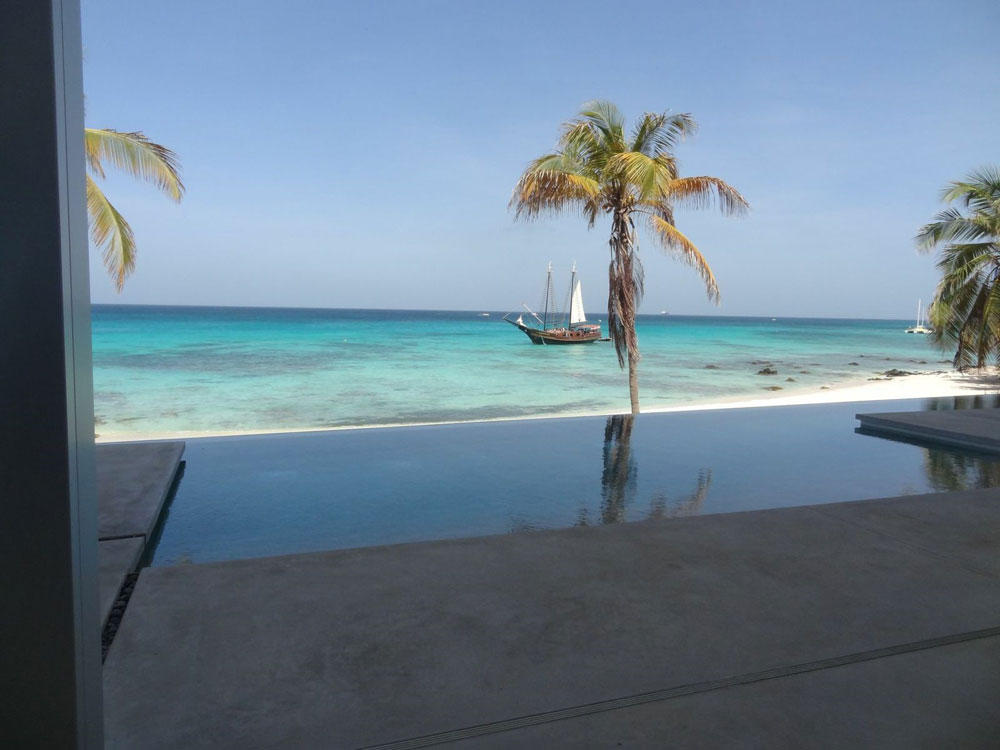
Aruba is a small island in the southern Caribbean. It is a tropical getaway for travellers seeking sunshine and crystal blue waters. In 2012 Tom Ralston was invited to consult on a building project located on this idyllic island.
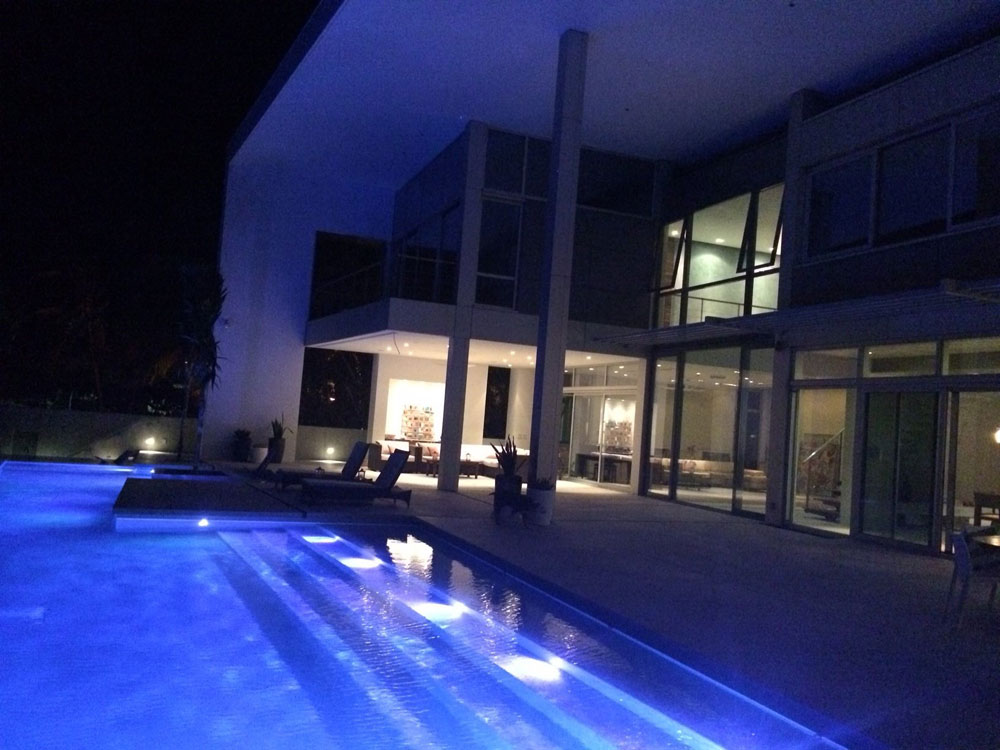 The 8000 square foot modern home, designed by Architect Gary Ostermann was no small task. Started in the fall of 2013, they finished the project on Easter Sunday, 2014.
The 8000 square foot modern home, designed by Architect Gary Ostermann was no small task. Started in the fall of 2013, they finished the project on Easter Sunday, 2014.
Tom Ralston and the crew took on the massive project and after working hard all day, they'd cool off and dive along the world class reefs that lay just beyond the deck of this ocean front home. A little perk to the job site.
On top of the 8000 square foot residence, an additional 8000 square foot exterior, including a gorgeous lap pool with an endless edge, was added to the overall project. The house and surround has an incredible modern architectural flair that is light bright and serves homeowners and guests extremely well.
The upstairs library and study, bedrooms, and guest rooms have a blend of color hardener that is different from the lower concrete floors while the pool deck and exterior have another blend of color and texture. All in all, the project is simply stunning.
Tom remarked that the project came together due to his rock star crew, tedious preparation and planning everything out well in advance. He would also like to thank the client for being a positive and knowledgable person to work with.
Tom shares some of his stories, insights, and advice about the Aruba project in the question and answer session below. See more Q&A sessions with Tom in the Master Q&A blog.
Aruba Project Q&A
How Did You Get Connected with the Client for the Aruba Project?
TR: The client is the CFO for a state of the art concrete plant in Aruba called ATCO. It happened that a representative from Granite Rock, our concrete plant here in Northern California, was connected with the client and his company ATCO. When asked about who to call for concrete floors, Granite Rock mentioned Tom Ralston Concrete as someone who does a lot of decorative concrete floors in California.
Even more serendipitously, the client's architect, Gary Ostermann, is from Berkeley. So Gary came down to Santa Cruz to discuss the possibility of the Aruba project. Soon after we flew down to Aruba to interview with the client and put a proposal together. Things went well and we got the job.
The client ended up being one of the most enjoyable and informed clients I've worked with. It is always a treat to work with someone like that - clients like him are often hard to find.
How Do Your Years of Experience Play into Completing a Job Like This?
TR: The Aruba project was project management on steroids. There are so many things you have to consider ahead of time. You have to do an extreme amount of planning - if you forget anything, any specialty tool, any material, any piece of equipment you might need - you're out of luck.
My office manager Rachel Chatham was very instrumental in helping me put this project together. Without her aid, I don't know if we could have done this - of course, having a reliable and professional crew is crucial to the success of any project.
The reality is that things become much more complicated when you're working in such a remote environment - Aruba is something like 4,000 miles away from Santa Cruz as the crow flies. Difficulties include the fact that you're working in a foreign country, on a remote island, in a place that is known for high winds and hot temperatures.
One of the difficulties we had was dealing with the wind, the sun and the heat - we had to pour in the dark when it was cool and less windy. We even had a t-shirt made up that said, "Team Aruba: Pouring at Dark-Thirty".
We had to tarp the entire expanse on the exterior everytime we poured to protect the concrete from the sun. A few times the wind almost blew over the tarps, but we did a very good job of securing them. The company from Holland named ALBO, were tremendous in their efforts and their help.
Another difficulty was the continued planning and strategy that was necessary every single day as the project moved forward - how we were going to tackle the next day's pour, how we were going to get everything done in the timeframe that we had. We went down there 5 times for ten-day stretches. We had to pack a lot of work into those time periods. Basically, we poured 16,000 square feet in that time - there was a lot to consider. There was blending color hardeners - three different colors to blend in order to get the color that was desired. Every expanse - lower floors, upper floors, exterior decks - all had different blends. There were different blends of color and they all had to kept straight and consistent. It was a challenging project in that way as well.
What Are Some of The Enjoyable Aspects of Taking a Project Like This On?
TR: One of the enjoyable aspects is meeting new people - meeting all of these Dutch construction workers from this company, ALBO. Also, getting immersed in the culture of Aruba, the culture of the Caribbean. We were blessed to have great accommodations - the house that we worked on was right on the beach with a stellar ocean view. It had an endless-edge lap pool.
One of my favorite parts of specialty projects like this is getting so much appreciation from the locals and from the Dutch construction company - they loved what we did there and we all appreciated each others' work and involvement. That's always a great feeling. My guys that I brought with me were kind of like rockstars over there - we ended up giving t-shirts back and forth with everyone involved. You know, the relationships were great, the island was exceptionally nice - it's one of the most popular vacation spots in the world with beautiful beaches.
It just so happened that right in front of this 8,000 square foot home is one of the most pristine diving areas in the world. In fact, every day it had 20-40 people that were dropped to dive and see all the beautiful ocean life.
We would go out diving after work some days and enjoy it ourselves.
Do You Have Any Other Thoughts or Advice from Taking on the Aruba Project?
TR: One thing I would mention is that, if you ever decide to take on a project as large as this one that TRC did in Aruba, you have to be very detail-oriented with what you are going to need, what kind of crews you'll need. You need to do a vast majority of the work ahead of time. Do as many mockups as it takes to get to the final product that you will be providing to the owner. For the Aruba project we did a lot of mockups and color examples with the architect.
Any Story that Stands Out?
TR: There was a little area that we had to do a skim coat on. It only needed to be about a 10 millimeter thickness and it had to match another complex color blend. What we had to do was sift our color hardener, which was sands and cement and pigment, so that we could sift the sand out so that we could make this very thin skim coat. I needed something like a strainer to sift it in, and I couldn't find a strainer anywhere! None of the paint stores had any strainers, and typically that's where we get our strainers here on the mainland. So finally I decided to go to a women's hosiery shop and asked if they had any nylons. And the woman who spoke some English said, "For You?". And I said, "Well of course!" - and we got a good chuckle out of that.
All in all the Aruba project was an amazing experience, and I am always excited to work with international clients to create challenging and rewarding projects.
Stay tuned for next month's featured project. Check out more of Tom Ralston's work here. Have any questions or comments? Feel free to contact us.
You can stay updated with the latest from Tom Ralston Concrete by following us on, Facebook, Instagram, Linkedin, or Houzz.
- Details
- Written by: Tom Ralston Concrete
Greetings and welcome to the Master Q&A. In this edition Tom shares the history of his years in the concrete world, illuminates the importance of inspiration, and describes why to maintain a balance of form and function in creative work. Inspiration and information for the home owner, contractor, and designer.
Can you give us a brief history of how your family got started in the concrete industry, and when TRC was founded?
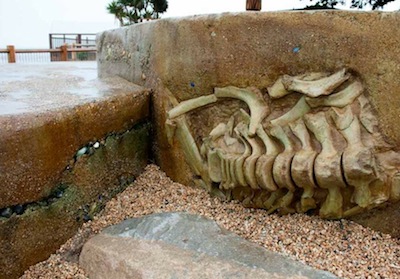 Tom Ralston My Grandfather, Wilber Thomas Ralston started the Ralston concrete company in 1928. He started in Boulder Creek, CA about 14 miles north of Santa Cruz. My father, Jim Ralston got his license in 1959. Finally Tom Ralston Concrete was founded in 1989.
Tom Ralston My Grandfather, Wilber Thomas Ralston started the Ralston concrete company in 1928. He started in Boulder Creek, CA about 14 miles north of Santa Cruz. My father, Jim Ralston got his license in 1959. Finally Tom Ralston Concrete was founded in 1989.
What are some notable works your grandfather and father have completed around town?
T.R. My grandfather worked on the boulder Creek Dam. My Father would tinker around with artful things in concrete all the time. I remember my dad and I built this drive way for Janet Stagnaro on the west side of town. He made his own set of wooden stamps that embossed the concrete in a very unique way. It looked like the way they pour and stamp concrete on the steep hillsides in San Francisco.
When did you take over the business and what inspired you to take it in the direction you did, (with more of an emphasis on decorative/artistic inspired works)?
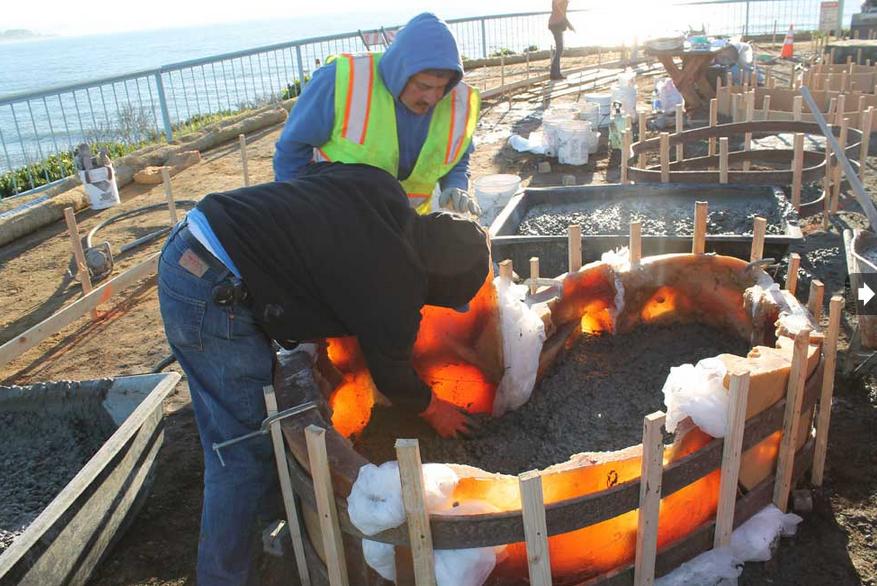 T.R. I was just doing concrete work on the side, which I thought I would never want to do. I had been in Kauai for a few years, living the life over there.
T.R. I was just doing concrete work on the side, which I thought I would never want to do. I had been in Kauai for a few years, living the life over there.
I felt it was time to settle down and my dad said he was going to retire. The initial inspiration was to be able to support myself in a good way.
I started doing more concrete work and within a few months I was asked if I wanted to do a house for a local business man. He had us work on his Victorian home. It was very inspiring to take something that is soft and formable like concrete, and turn it into a piece that's durable and long lasting. So that's where I got my initial inspiration.
What are some of your inspirations outside of the concrete world that have helped spark your imagination for what is possible with concrete?
T.R. I believe that architecture is a huge inspiration. I love going to big cities and looking at the architectural work. So much of it is done in concrete. Cities like; Rome, London, Paris, Prague, and Dubrovnik. Those places have huge inspiring works, and they show you what is possible.
I also find inspiration from nature. We deal with coloration of concrete in very unique and artistic ways. So we are inspired by a sunset, the ocean, rocks, a mountainside, or in a meadow...it's endless. So I get a lot of inspiration from just looking out my windows sometimes.
Are there particular artists, designers, or architects you derive inspiration from?
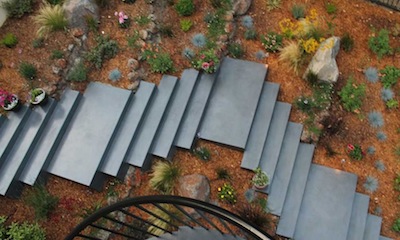
T.R. Absolutely there are tons of them! If I start with artists, Van Gough is one of my favorites, also Picasso. Picasso in particular was a man who could paint but also sculpt. He actually would use concrete to sculpt with.
For designers there's Antonio Gaudi. He has amazing works in Barcelona that he's famous for. Projects that have gone on for hundreds of years. The things that he did with concrete and stucco are mind boggling and absolutely amazing.
There's a female architect named Zaha Hadid and she has done design work all around the world. She's done these serpentine structures in Abu Dhabi and in New York. She's an incredible inspiration.
Of course, Frank Lloyd Wright loved to build with concrete. He's an inspiration.
You might not know this but Thomas Edison was a huge concrete aficionado and actually built a concrete piano. He wanted to build houses on an assembly line out of concrete.
What advice would you give to a young decorative concrete contractor in terms of balancing function with artistry? Or balancing both of those with the needs of the client?
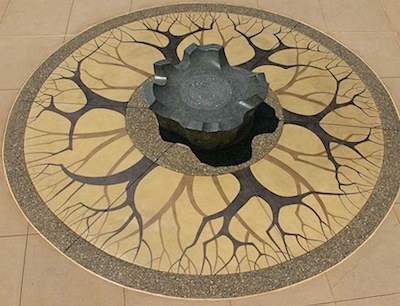
T.R. Always stay green and growing. Also, function and artistry are equally important. Most of my work has to have a function and it has to function correctly.
You can have all the artistry you want but if it doesn't function well, then it's really kind of useless.
So with your art you have to incorporate science. It's important to write copious amounts of notes and mockups, in order to incorporate art and function.
When it comes to the client you need to know exactly what the client wants. So mock up what they want and go from there!
-Alright folks, that's it for this month's Decorative Concrete Master Q&A, join us next time for more stories and knowledge from decorative concrete master Tom Ralston. We post these Master Q&A's on the first and Friday of each month.
Submit your own questions here, and to find more information check out Tom's books on decorative concrete. Also, we'd love it if you'd come over and say hello on one of our social sites. Follow us or like us for more expert decorative concrete knowledge on Houzz, LinkedIn, Facebook or Instagram.
- Details
- Written by: Tom Ralston Concrete
The Contractor/Client relationship is no different than any other relationship. There's a balance that needs to be maintained. In this Q&A Tom shares advice for contractor and client alike. Remember, it's all about communication. Read on and do great work.
How do you identify an ideal client?
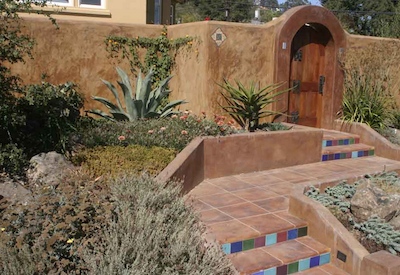 Tom Ralston: As a decorative concrete contractor the client we love to work with is passionate about aesthetics and excited about the realm of possibilities that concrete has to offer. It's these clients that we can engage with and talk about ideas of things to create within the medium of concrete.
Tom Ralston: As a decorative concrete contractor the client we love to work with is passionate about aesthetics and excited about the realm of possibilities that concrete has to offer. It's these clients that we can engage with and talk about ideas of things to create within the medium of concrete.
The ideal client also is not so constricted on budget, although all projects have to have a reasonable cost. When doing projects that are both decorative and exciting, it just costs more money. The ideal client understands that and they're willing to pay more for a memorable and exciting product.
What are some of the criteria you use when deciding who to work with? How has that criteria changed over the years?
TR: The criteria I use to decide who to work with is pretty extensive. I've actually written a small treatise on signs of a problematic client. It raises a few red flags to watch out for.
First, a client that goes back and forth on ideas can cost both time and money.
Second, clients that want to go over every single line item and ask how they can save money causes the budget to become the main focus of a project. It becomes less about the project and what the final product will look like and more about the money.
Third, a 'do it your self' client that wants to do 70% of the work him or herself and have the contractor do just a little piece of it can definitely complicate jobs.
To answer the second part of the question, the way the criteria has changed has been through job costing. We document as much as we can. My site managers, my office manager, and myself try and document what project has had problems, how those problems come about and why.
We ask questions like; what are some of the reasons there were problems? Who was the client? What were the conditions? Answering these questions help us understand all the aspects of running a successful job and the inherent risks. When you know what the inherent risks are that can affect how much time various projects will take and what will drive up costs. Costs equal more money and money can equal stress. Our criteria changes as we continue to analyze jobs and see what went wrong and what went well.
Can you give some advice to concrete contractors out there on how to deal with challenging clients?
 T.R: Try to get everything on paper and leave no stone unturned if possible. Write out everything that you possibly can. A good friend of mine said, "if it's not written it doesn't exist". You need to be very clear and concise. Basically communicate as efficiently as possible.
T.R: Try to get everything on paper and leave no stone unturned if possible. Write out everything that you possibly can. A good friend of mine said, "if it's not written it doesn't exist". You need to be very clear and concise. Basically communicate as efficiently as possible.
What are some of the most common problems that arise?
T.R: Things like scope of work, what is included and what is not. You have to have everything specifically stated in contracts. Things need to be agreed upon, everything needs to be clear in the beginning so problems can be eliminated. With decorative concrete if a schedule isn't kept things can become rushed. That can lead to a final product can sometimes turn out less than stellar.
What advice can you give to homeowners, architects and anyone else in terms of choosing the right contractor to work with?
T.R: Do your own digging. By that I mean ask for references, check out their work, communicate with them ahead of time and bring in all of the parties that are responsible for the final product, i.e. architects, clients, contractors, and homeowners. Get everyone together to discuss the project at length.
I really enjoy that part of the process because it gives me the opportunity to expound upon various details and little nuances that concrete can have and it also allows me to understand if I'm going to be a good fit for a particular client or not. Engage in as much communication as you can with potential contractors and get to know them to see if they are right for your project.
Any advice for clients on how to deal with a challenging contractor?
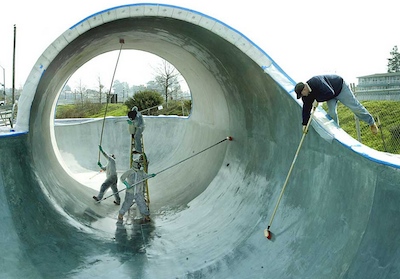 T.R: A client has quite a bit of leverage when dealing with a contractor; they are writing the checks and giving the go ahead. It may be a good idea for a client to hold back payments if there are things that are not completed as per your agreement.
T.R: A client has quite a bit of leverage when dealing with a contractor; they are writing the checks and giving the go ahead. It may be a good idea for a client to hold back payments if there are things that are not completed as per your agreement.
The client also has a lot of sway with the board of contractors or any state license board. Make sure to have everything in writing. For example, saving all the emails that have been exchanged. That is a great way to build a case if that becomes necessary. Hopefully it won't be, but either way it helps keep track of the way a project is going.
Will you share a personal experience you've had dealing with either a challenging client, contractor, or both? What are some of the most challenging experiences you've had? What about the most rewarding?
T.R: I've been in the concrete business for a quarter of a century. I have had challenging experiences with clients and contractors both. Some clients say they just won't pay because the product has not come out to their satisfaction. Things just don't turn out the way they're expected to sometimes.
So much can compromise a concrete finish. You may have some product that just won't perform the way it should. I've had concrete freeze overnight and pop the next day and I had to jackhammer it all out. What are you gonna do? Sometimes it's just easier to go fix what's happened even if it does cost time.
I have had experience working with challenging contractors, there have been so many cases where contractors have been outstandingly bad.
The most rewarding moments with a client comes when a friendship is made. It's very rewarding to hear a client rave about your work and they absolutely love what it is you do. If the end result has come out really nice and the relationship has been fostered well you can end up making a great friend because of a job. Also some of the work TRC has completed on public display gives me a great sense of satisfaction.
Alright folks, that's it for this week's Decorative Concrete Master Q&A, join us next time for more stories and knowledge from decorative concrete master Tom Ralston. We post these Master Q&A's on the first and third Fridays of each month.
Submit your own questions here, and to find more information check out Tom's books on decorative concrete. Also, we'd love it if you'd come over and say hello on one of our social sites. Follow us or like us for more expert decorative concrete knowledge on Houzz, LinkedIn, Facebook or Instagram.
- Details
- Written by: Tom Ralston Concrete
When it comes to the world of concrete third generation contractor Tom Ralston has seen everything under the sun, and he's picked up quite a few lessons and tricks of the trade. Most of the advice found below is not limited to the concrete world and can be applied to running a successful business of any kind. Read on to gain years of experience in just a few paragraphs. What drives you to become the best in your field?
How have you seen the decorative concrete industry change over the decades that your family has been in the business?
 Tom Ralston: I should clarify that my grandfather and my father weren't involved in decorative concrete specifically. The work they did was more standard concrete work; the laying of foundations, sidewalks, and patios.
Tom Ralston: I should clarify that my grandfather and my father weren't involved in decorative concrete specifically. The work they did was more standard concrete work; the laying of foundations, sidewalks, and patios.
Occasionally they would cast and place an exposed aggregate patio, something with a little color. However, not really much in the way of decorative concrete when compared with what some folks are doing with concrete today.
So to answer the question, the concrete industry has changed dramatically. I come from a small family business where my father and grandfather used to do business on a handshake. Today there's just a lot more competition and now you've got to make sure you're covering your bases with contracts. People are more inclined to go to litigation these days and it's really somewhat rampant. So, you have to protect yourself a lot more, at least that has been my experience.
What has your experience been with specializing in decorative concrete?
TR: It is a risky business in that it's really hard to control every facet of what makes the concrete decorative concrete. Once you go with a decorative concrete piece the expectations rise exponentially. People look at decorative concrete work with a magnifying glass, exploring every detail. It's not like standard grey concrete where expectations aren't as high.
How do you make a profit in the concrete industry while running a successful business with happy employees and clients?
 TR: The only way you can make a profit in the concrete industry is by having good employees. If you have good employees hopefully they're happy employees. That brings up the question, "how do I keep them happy?" To answer that the basic tenet is that you have to get work for them constantly.
TR: The only way you can make a profit in the concrete industry is by having good employees. If you have good employees hopefully they're happy employees. That brings up the question, "how do I keep them happy?" To answer that the basic tenet is that you have to get work for them constantly.
You can't let your employees go without work. That's the key to an employee's satisfaction. He or she needs to work. So you have to be responsible as an employer to make sure that you have work for your employees. Of course you need a steady flow work to make a profit as well!
As for happy clients you just do good work, do what you say you're going to do, and show up when you say you're going to show up. Hopefully you not only meet a client's expectations but exceed them.
Going back to the first part of the question, it's a really tricky business to make a profit in. First of all, you need your estimates to be correct and have enough profit built into them. Much of the work that we do is so risky so we instate a contingency for each job.
Secondly, you need good management. Managers that understand what the project is and how much time you should have to do it. It's important to develop and manage efficiencies. You need to estimate your project well, manage your project well, and third, of course, you need to make a good product for your client.
What are some of the most important lessons you have learned from your experience?

TR: Oh there's so many lessons that I've learned! To begin always stay green and growing, always be a student of what you're doing, and always learn. It's important to keep your talent, by that I mean keep your good employees. You need great employees in the decorative concrete field.
Usually you're only getting a five hour window of opportunity to get everything right. So you need to understand that and having great employees increases the chance of a successfully completed job.
In order to keep a successful business running, you have to keep the pedal to the metal. You have to be aggressive with your leads and go after work. You have to be revved up with a lot of energy so you can keep work flowing. You need that, it's very important.
What do you do try and do on a daily basis to keep things at TRC running smoothly?
TR: I'm always keeping my finger on the pulse of the company. I'm looking at details and processes, I try to be proactive with my procedures, and using foresight to see any potential pitfall so I can prevent a problem from occurring. Because, in the decorative concrete industry there are so many pitfalls and so many landmines that you need to be aware of and try to avoid.
Do you have any advice for dealing with those inevitable moments when things don't work out as planned?
TR: Take notes, make a study of what went wrong. Record the reasons things haven't worked out. Treat it like something that's continually growing and needs to be thought out and worked out. So then, in the future you don't make the same mistakes twice. That's achieved by duly noting what it was that you did.
For example; with decorative concrete sometimes we're mixing three or four different colors together or we're acid staining with one part acid four parts water as a ratio, or we're sealing concrete with an impregnating sealer and others with a satin or an epoxy sealer, and on and on... So you need to record all of these things and to be a student of process and study things especially when they don't work out.
If you could end this Q&A with some fundamental advice for a young person trying to break into the concrete business what would it be?
 TR: Well, in hindsight it would be hiring great people. If you hire great people your company will become great. As long as you have the understanding of the necessity of talent. Be Careful for who you hire. I've made some bad hires and some incredibly good hires.
TR: Well, in hindsight it would be hiring great people. If you hire great people your company will become great. As long as you have the understanding of the necessity of talent. Be Careful for who you hire. I've made some bad hires and some incredibly good hires.
There's a book that James C. Collins, a stanford business professor, wrote called Good To Great. One part of the book talks about hiring and to paraphrase, there's a part that goes, "if you don't have the right people on the bus you're not going to have a very good journey."
I would say that it is key to know your own business, know what you want to do, and be driven to do it. Make those really good hires and be on the lookout for really good talent. Keep good records, watch out for really risky projects and watch out for clients who may be problematic.
Some of the best experiences I've had have been through failure. There's that old saying that goes, "necessity is the mother of invention", and I say, "desperation is the father".
When everything goes wrong it can be an opportunity to get really creative, and that's a good thing. Unfortunately, it can be painful at times but pain can drive you too. By the end you find out how resourceful you can be and moving forward every failure makes you a better contractor.
Alright folks, that's it for this week's Decorative Concrete Master Q&A, join us next time for more stories and knowledge from decorative concrete master Tom Ralston. We post these Master Q&A's on the first and third Fridays of each month.
Submit your own questions here, and to find more information check out Tom's books on decorative concrete. Also, we'd love it if you'd come over and say hello on one of our social sites. Follow us or like us for more expert decorative concrete knowledge on Houzz, LinkedIn, Facebook or Instagram.
- Details
- Written by: Tom Ralston Concrete
In this week's Q&A Tom speaks about how the Volatile Organic Compound Laws have affected many niche trades. In the concrete world the VOC laws have changed the make-up of concrete sealers. Read on, learn the facts, and go do great work.
How effective were sealers before the new, stricter VOC laws? What have the VOC laws done to sealers in terms of their effectiveness?
 Tom Ralston: Well first, VOC stands for Volatile Organic Compounds. Before they started restricting the organic compounds contained in each sealer they were much more effective. In fact, we could get away with sealing concrete the day after a pour because they were so "hot".
Tom Ralston: Well first, VOC stands for Volatile Organic Compounds. Before they started restricting the organic compounds contained in each sealer they were much more effective. In fact, we could get away with sealing concrete the day after a pour because they were so "hot".
They had a much higher percentage of the organic compounds. They flashed off a lot quicker and performed significantly better. So the VOC laws have weakened the sealers and they are not nearly as effective today in 2014
What are the most common problems and misconceptions concerning the VOC laws?
TR: A common misconception is that the sealers are as effective as they used to be and they're not. The most common problem is that they fail. Today's sealers fail in many different ways; they fail by fish-eyeing and not laying down flat, they fail by scaling and coming off, and they fail by whitening.
We've found that the solvent based acrylic sealers are less prone to whitening than the water based sealers. However, both the solvent and the acrylic will fail regardless if the conditions aren't right.
There are all kinds of sealers; there's acrylic, epoxy, penetrating, polyurethane sealers, polyaspartic sealers and the list goes on. Also, there are all kinds of different combinations of components. In other words there are different formulations of each one of those categories. So every manufacturer can potentially have their own formulation of these particular types of sealers.
How have the VOC laws changed the way you do business? How have they affected other contractors in the decorative concrete world?
 TR: Well, they have changed the way I do business at TRC by being considerably more careful. We do not guarantee any sealer used because the sealers are so ineffective. It's almost like, "seal at your own risk". That being said, when they do fail we come back because we're a good concrete company.
TR: Well, they have changed the way I do business at TRC by being considerably more careful. We do not guarantee any sealer used because the sealers are so ineffective. It's almost like, "seal at your own risk". That being said, when they do fail we come back because we're a good concrete company.
Either way, sealers can be very problematic especially in the colder and wetter months. You simply don't want to seal when those months come around, unless you go to great lengths to dry the concrete. Sometimes we heat the concrete to bring it to an ambient temperature of 60 degrees or more. That's usually the rule of thumb, you need your concrete surface to be 60 degrees or more. How ever you don't want to seal anything that's warmer than 85 degrees. This is because the sealers, especially solvent based, can bubble.
I have also specified this in my statement of limitations that it's pretty much a "seal at your own risk" policy.We just can't be responsible for sealer failures. If a client wants us to come back and fix a failed sealant we will, but we're going to have to charge them to do that. It can get to be a sticky situation when you have a client that has spent quite a bit of money with you or is just a really good client. So we pretty much bend over backwards to make things right. It's just good to have in writing that you're not going to guarantee a sealer so at least you have a leg to stand on if you're going to try and seek remuneration or be recompensed.
The new VOC compliant sealers have affected other contractors the same way. We all have to be a lot more careful with what we do and how we seal.
How do you deal with the problems that the less-effective sealers create?
 TR: Well, we're just more careful. We make sure that we always have optimum conditions. In the winter when we get good weather we usually don't start sealing till noon or one o clock. And then sometimes we'll heat the sealer with a torch. If it's a small area we'll heat the sealer with a blow dryer. When we use the acrylic solvent sealer we cut it in half with a solvent like lacquer thinner so it can be applied with an airless sprayer. With this style of application the sealer lays on extremely thin and that promotes a successful seal because it can help the sealer cure and not be as problematic.
TR: Well, we're just more careful. We make sure that we always have optimum conditions. In the winter when we get good weather we usually don't start sealing till noon or one o clock. And then sometimes we'll heat the sealer with a torch. If it's a small area we'll heat the sealer with a blow dryer. When we use the acrylic solvent sealer we cut it in half with a solvent like lacquer thinner so it can be applied with an airless sprayer. With this style of application the sealer lays on extremely thin and that promotes a successful seal because it can help the sealer cure and not be as problematic.
Is there anything you can add that isn't covered in the above questions that would be important information for both contractors and clients alike? Particularly up and coming decorative concrete contractors?
TR: Well, I would say that you should do tests on any given sealer that you use. Do copious amounts of tests and see exactly what it does on different applications. If it's a concrete counter top, an outside patio, or an interior floor, do plenty of mock ups. Use different products and compare those products.
If you want to see if a particular impregnating sealer is going to prevent concrete from staining you can use 3 different impregnating sealers and come up with one that is more resistant to salad oil, table wine or things of that nature. Although no sealers are impervious some perform much better than others. The only way you can get this information is to do your own mockups and tests.
Do you have any other advice you would share with regard to the VOC laws and still creating projects that look great?
 TR: Well, you need to be very careful. Take notes and record what works and what doesn't. See what products work what products don't. One thing that I didn't mention was that we have an infrared temperature gauge. It will tell you how warm or cold the concrete is. The same with moisture, you want to get a moisture reader so that you can see if your concrete is dry enough to seal. Because moisture laden concrete is going to prompt your sealer to fail just as cold concrete will cause a sealer fail.
TR: Well, you need to be very careful. Take notes and record what works and what doesn't. See what products work what products don't. One thing that I didn't mention was that we have an infrared temperature gauge. It will tell you how warm or cold the concrete is. The same with moisture, you want to get a moisture reader so that you can see if your concrete is dry enough to seal. Because moisture laden concrete is going to prompt your sealer to fail just as cold concrete will cause a sealer fail.
Alright folks, that's it for this week's Decorative Concrete Master Q&A, join us next time for more stories and knowledge from decorative concrete master Tom Ralston. We post these Master Q&A's on the first and third Fridays of each month.
Submit your own questions here, and to find more information check out Tom's books on decorative concrete. Also, we'd love it if you'd come over and say hello on one of our social sites. Follow us or like us for more expert decorative concrete knowledge on Houzz, LinkedIn, Facebook or Instagram.
- Details
- Written by: Tom Ralston Concrete
In this volume Tom gives us the run down on aggregate. Everything from what its basic function is, to what kind of aggregate looks best in an exposed finish. Warning: Learning this information may lead to you becoming a concrete master.
Can you please explain what aggregate is and what is its function in a concrete mix?
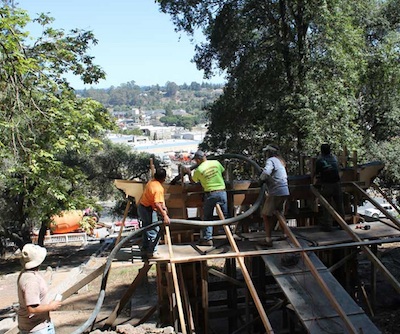 Tom Ralston: Aggregate is a term used to describe sand, gravel, crushed stone, slag, or anything like that. It is the material that is used to turn cement into concrete.
Tom Ralston: Aggregate is a term used to describe sand, gravel, crushed stone, slag, or anything like that. It is the material that is used to turn cement into concrete.
Cement placed by itself is typically very weak and will crack or craze. The aggregate is necessary, and when added it becomes concrete. So, the function of the aggregate is that it adds strength and holds everything together. It makes everything more structurally sound.
Why is larger aggregate superior to smaller aggregate (pea gravel)?
TR: The larger the rock, the more mass you have in a cubic yard of concrete. A cubic yard of concrete is 3' x 3' x 3'. So it's basically a big box. If you add aggregate that is larger it will fill up more of the box with a solid component. Thus, it will make the mix that much more structurally sound.
The shape of the rock is also important. Angular rock locks together better than round rock. Round rock really can't clasp on as tightly as an angular rock that's chipped. The chips fit together more easily and intermesh better than round rock.
We always use the larger aggregate for slabs, as large as we can fit in the mix. Typically three-quarter inch aggregate. Also, the larger aggregate means less sand, and if there's less sand there's less water needed to make it workable.
Water is a necessary evil, it allows the concrete to become supple and workable, but if you use too much of it there's a likelihood of excessive shrinkage cracking. So, if you can eliminate the smaller aggregate and increase the amount of larger aggregate you then decrease the amount of sand, thus making your mix stronger.
Is the amount of aggregate used in a mix always the same or does it vary?
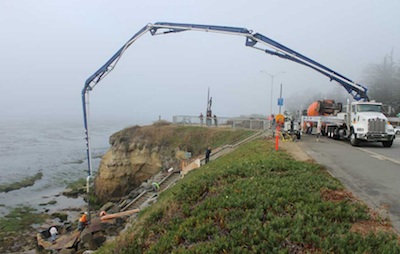 TR: Yes it varies, and the different mixes means using different equipment. Sometimes the smaller concrete pumps cannot pump a mix that's loaded with large aggregate/rock. Because it won't go through the hose. The small pumps need more cement and more sand.
TR: Yes it varies, and the different mixes means using different equipment. Sometimes the smaller concrete pumps cannot pump a mix that's loaded with large aggregate/rock. Because it won't go through the hose. The small pumps need more cement and more sand.
A grout pump will pump pea gravel and smaller aggregates easily. When you get into three-quarter inch aggregates you need a larger hose and different pump. That's called the line pump. And then when you get into a bigger pump, which is a boom pump or overhead pump, it's possible to pump mix designs that have a higher aggregate content. Tom Ralston Concrete uses an overhead pump when we're doing seamless floors with a really high aggregate amount in the concrete mix design.
Do you need to add aggregate to your mix even if you're not seeking an exposed aggregate finish?
TR: Yes, aggregates are a necessity in all concrete mixes. Even when you're not exposing the finish. Sometimes we add a special aggregate so we do not have to seed or additionally broadcast aggregates. Exposed aggregate is a whole different medium, actually an art form.
What's your go to aggregate for a project, and which one looks the best?
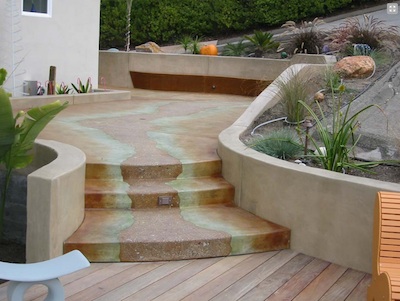 TR: I love mexican pebble, I love black la paz, pammy, I'm not a fan of yuba quartz which is black and white. But we have used it and it's been done tastefully.
TR: I love mexican pebble, I love black la paz, pammy, I'm not a fan of yuba quartz which is black and white. But we have used it and it's been done tastefully.
Do different types of aggregate change the cost of a job?
TR: Absolutely. One time we used this sunburst cobble, which is bigger than fist size going down to two or three inches. Its imported from the Grand Canyon, any time aggregates have to be imported it gets very expensive. A ton can cost you $800-1200 while a typical ton can cost you $200-300. So yes, it can change the cost of the job.
Will you share a remarkable or funny story that could be relevant to this discussion?
TR: One time we had to do a client's driveway down at the Santa Cruz yacht harbor. We had to import aggregate from Arizona and make planks so we could broadcast this aggregate and place it in artful ways and positions. And It was really quite a process. Sometimes we had 20 foot planks so we could get across the expanse and drop in the aggregates to create a big vein.
Another time, we worked with an architect in Carmel named Ray Parks where we used aggregates as big as 30 inches in diameter, huge rocks that were 3-400 pounds a piece. And we placed those at the outside perimeter of the job and then we made these veins that went in and out of the deck surface. It was gorgeous, absolutely gorgeous.
What is the biggest lesson you've learned about aggregate that could help out a novice or someone just starting in the Concrete business?
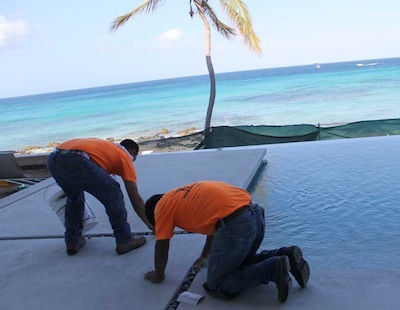 TR: One of the biggest lessons I could share is not to use pea gravel or small aggregate in flat work. Because the amount of sand used and the amount of water the pump adds to make it wet/slick enough for it to pump through does a huge disservice to the slab and usually jeopardizes its integrity and the slab ends up cracking.
TR: One of the biggest lessons I could share is not to use pea gravel or small aggregate in flat work. Because the amount of sand used and the amount of water the pump adds to make it wet/slick enough for it to pump through does a huge disservice to the slab and usually jeopardizes its integrity and the slab ends up cracking.
And I'll also warn that although the exposed aggregate finish is one of the oldest decorative concrete treatments in the 20th century it's also one of the most difficult. Don't think that doing a good exposed aggregate job is going to be easy. When we do it we have one man responsible for about 250 ft, when you start doing a really good exposed aggregate job, that calls for the aggregate to be blanketed and tightly spaced, we only figure 1 man every 90 feet. It's a huge impact on labor and hence affects cost.
Alright folks, that's it for this week's Decorative Concrete Master Q&A, join us next time for more stories and knowledge from decorative concrete master Tom Ralston. We post these Master Q&A's on the first and third Fridays of each month.
Submit your own questions here, and to find more information check out Tom's books on decorative concrete. Also, we'd love it if you'd come over and say hello on one of our social sites. Follow us or like us for more expert decorative concrete knowledge on Houzz, LinkedIn, Facebook or Instagram.
- Details
- Written by: Tom Ralston Concrete
In this volume of Decorative Concrete Master Q&A, Tom Ralston enlightens us on the subject of using color in concrete. There are two methods discussed, the first is integral color, the second is dust-on color hardener. Tom explains processes, do's and don'ts, cost, and shares personal experiences with using color in decorative concrete - giving expert insight from his 30+ year career.
Briefly, what is integral color and what is dust-on color?
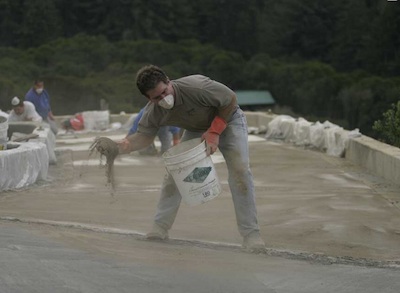 Tom Ralston: Integral color is simply pigment, pure pigment, put inside the drum of a concrete mixing truck. This is all done at the concrete plant. Pigment is added with water and the water is then mixed in the drum with the cement, sand, and aggregate.
Tom Ralston: Integral color is simply pigment, pure pigment, put inside the drum of a concrete mixing truck. This is all done at the concrete plant. Pigment is added with water and the water is then mixed in the drum with the cement, sand, and aggregate.
Dust on color is pigment mixed with sand and cement. It's stored in a bag or bucket and it is broadcast mechanically or by hand after the natural concrete has been poured.
What are the benefits and downsides of the dust-on and integral color methods?
Tom Ralston: Well, we here at TRC prefers dust on, but here are the benefits and downsides of each...
Integral Color
Integral color is much easier to use because it's less labor intensive. The finishers do not have to open a bag, manually broadcast the color onto the surface, and then work it in.
The integral color that comes from the concrete plants is already mixed in the load so it's much more convenient. However, the integral color from the plant can be much more inconsistent.
There's very little control. If it takes three to four trucks to finish a job and one truck comes to the job with too much water, the color in that load will be different than the other trucks. If they come back to the plant and don't wash their trucks the loads can be a completely different color. That's an inherent problem many times with integral colored concrete. When the person mixing batches at the plant introduces color, they must be very consistent. If they're not the colors will vary between batches.
Dust-On Color Hardener
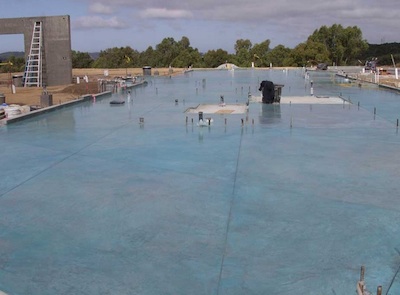 With dust-on color hardener, a finisher uses the same batch over and over. As long as the entire project has one batch from a manufacturer you should be good. If, however, you use batches of dust-on color from different years or manufacturers, you can have a similar problem in that the batches are not the same. One way to rectify that is to open all the color hardener buckets or bags and blend them together.
With dust-on color hardener, a finisher uses the same batch over and over. As long as the entire project has one batch from a manufacturer you should be good. If, however, you use batches of dust-on color from different years or manufacturers, you can have a similar problem in that the batches are not the same. One way to rectify that is to open all the color hardener buckets or bags and blend them together.
One of the benefits of using dust-on color is that you can use buckets from the original pour, store them, and if you ever have chips in the concrete or areas that need repair you can use the dust-on color hardener to repair the chips and get a perfect color match. If your concrete chips with integral color, even though the color is mixed throughout concrete you will have a difficult time matching the integral color, because you don't have the benefit of having that exact batch from the original pour.
One of the reasons a lot of concrete contractors don't use dust-on color hardener, is because it requires more effort, experience, and concrete craftsmanship to apply it. A lot of concrete masons aren't experienced with using dust-on color hardener.
The benefit for using dust on-color is that it becomes more of a dense surface, more scratch resistant - the colors hold better.
Integral color will variegate more easily, especially if you use some water on an integral color concrete. Using water on integral color usually spells disaster. It will bleed and come out in an unsightly mottled fashion.
What are your personal favorite applications of integral color?

Tom Ralston: You can use integral color on a countertop, a pool deck, on a swimming pool coping, on an interior floor... virtually any concrete pour can use integral color.
One of my favorite applications is when you have an exposed aggregate surface. For example say you use a red river rock as an aggregate, if you just put a small hint of red as your integral color when you do a wash off to expose the aggregate you don't see grey spots that will show up if you pour with no color added.
Predominantly in exposed aggregate surfaces there is going to be some negative spaces where the aggregate is not carpeted or tightly matrixed on your surface. Wherever there is a hole or space without colored aggregate, if you have an integral color in the load, those spaces become a lot less noticeable.
What is the cost difference of using integral color versus dust-on color?
Tom Ralston: Usually integral color starts with one pound per sack of cement. Each pound is around five dollars so it's around thirty dollars a yard. Two pounds of color-per-sack is sixty dollars a yard, three pounds of color per sack is ninety, four pounds of color per sack is one-hundred and twenty dollars. So you can see how expensive it can get. If you use green or a blue color they are more expensive for integral concrete - up to two-hundred dollars a yard.
The cost of dust-on color usually starts around sixty cents per square foot and it can go up to one dollar and fifty cents per square foot for using a bright white color. White colors get dusted on in four different applications! Whereas just using grey or brown you don't have to dust as much on, hence it costs less.
Can you tell a story about a remarkable use of integral color? A favorite project where you used it?
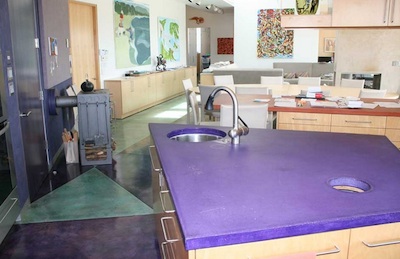 Tom Ralston: A few years ago we used a taupe color, where we had strips of brass running through the work. The walls that we poured were acid-washed later to give it a sand-wash exposure. It was for the Watson family Victorian home in Santa Cruz. The Watson home was owned by the family that Watsonville is named after. It was a remarkable use of integral color.
Tom Ralston: A few years ago we used a taupe color, where we had strips of brass running through the work. The walls that we poured were acid-washed later to give it a sand-wash exposure. It was for the Watson family Victorian home in Santa Cruz. The Watson home was owned by the family that Watsonville is named after. It was a remarkable use of integral color.
There is one other funny story I can think of using integral color- it was a last ditch effort. The client wanted a black color and when we got to the job we hadn't ordered the black color. The client was very upset, and I was trying to hold my calm. I said, "I'll be right back, I'll take care of it. Don't worry".
So I went to the concrete company (this is before I was introduced to dust-on color hardener), and grabbed bags of the black powdered pigment and then I flew back to the job in my truck. When I got there I dusted all the pigment on (this is not recommended practice) - just threw straight pigment on the concrete and worked it in with wooden floats until it was black as black could be.
Then we seeded aggregate on top of that and when we washed it off the next day the black held really well! That job was done in 1992 and 22 years later the project still has that black color hardener. When I finished the client looked at me and said, "Uh, I don't think this is the way you're supposed to do things". It was beautiful and it worked out for the best, I completely lucked out.
Alright folks, that's it for this week's Decorative Concrete Master Q&A, join us next time for more stories and knowledge from decorative concrete master Tom Ralston. We post these Master Q&A's on the first and third Fridays of each month.
Submit your own questions here, and to find more information check out Tom's books on decorative concrete. Also, we'd love it if you'd come over and say hello on one of our social sites. Follow us or like us for more expert decorative concrete knowledge on Houzz, LinkedIn, Facebook or Instagram.
- Details
- Written by: Tom Ralston Concrete
This volume of Decorative Concrete Master Q&A is inspired by a question that we received from concrete contractors in Australia about how Tom Ralston Concrete has used seaweed and other natural materials in decorative concrete. In this Q&A Tom references a project to highlight the process and use of custom made seaweed molds, check out the project here. Tom then goes into further detail about not only using seaweed in decorative concrete, but also the general aesthetic, function, utility and cost of using natural materials in decorative concrete jobs.
Tom, we are concrete contractors in Australia. I have been asked to see what we can achieve with seaweed. Are you willing to provide me with the process you use?
Tom Ralston: The way we made our seaweed molds was to harvest live seaweed from the Monterey Bay, bring it back, wash all the saltwater off of it, and make rectangular or square clay trays. We then embossed the seaweed into the clay - the clay was about a half an inch thick. If the seaweed were long strands, we had long rectangular frames filled with clay. If they were more square we'd have a square frame filled with clay. Then we rolled paint rollers on top of the seaweed to give it its impression. The next day we filled the clay molds with poly-urethane rubber and let that dry and cure, and it became a stamp - so that's how we made our stamps.
How can the use of natural materials add to the aesthetic and function of decorative concrete?
Tom Ralston: If you're talking about flagstone or rock, then that's pretty easy. Flagstone or rock is a natural material. If you make concrete that harmonizes in color with some of the elements of color in the rock or the stone or the flagstone, it will certainly enhance your concrete work. The other natural material you could use, that some may consider, are acid stains - which are made from iron-oxides from the earth, from minerals. The iron-oxide is turned into an acid. Myradic acid and water are used as a vehicle to take the iron oxide and transport them into the concrete matrix, and hence stain them. So that's another example of what I might consider, or someone might consider, to be a natural material - the acid stain. Again the other natural materials would be stone; however, placing wood in a close proximity of concrete can also be considered the use of a natural material.
Can you give examples of when you used seaweed or other natural ocean materials in your concrete?
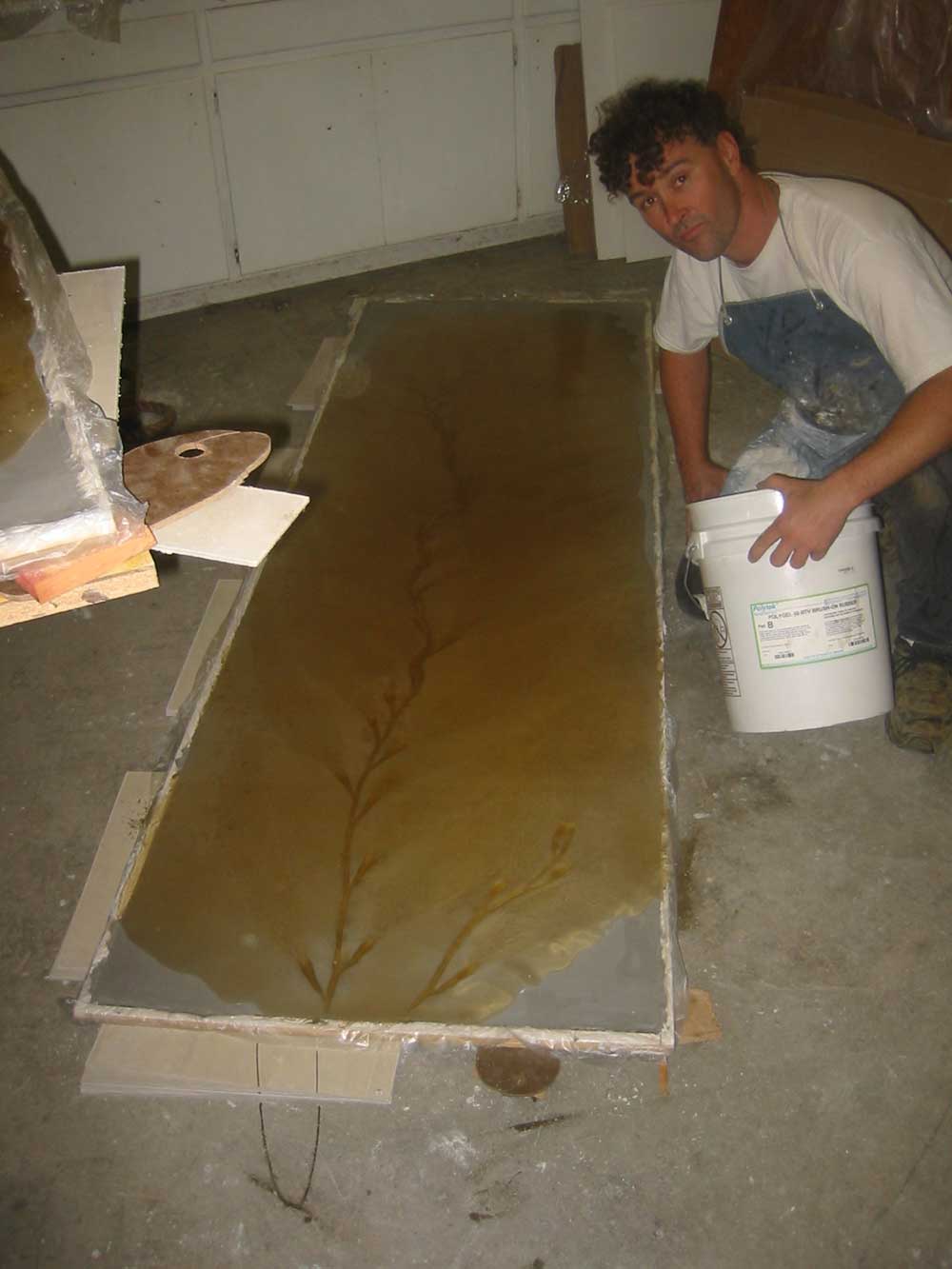
Tom Ralston: Yes, we used seaweed in a client's living room floor. The client wanted to have something that was ocean-themed. We started talking about how he lived right on the beach in Santa Cruz, and the conversation ended up at, "What would happen if there was a giant tidal wave? And what would your floors look like?". And I said, "Well the floors would probably look like they have driftwood and seaweed and other flotsam from the ocean that would indicate that there was a serious tidal wave, or flooding from the ocean's swells." That conversation was the genesis for this project.
So we made special molds, like I described earlier with the seaweed molds, and we stamped the client's floor. The floor was only ⅜" thick, ½" at the thickest point. And the molds, with the bulbs on the seaweed, were over a ¼" themselves, so it was almost to the point where the bulbs from the seaweed molds were going down to the floor, the bare floor, but it didn't do that. And then afterwards, we acid stained these pieces of seaweed that were stamped into the floor.
My associate Bill Goff did a technique that he came up with called a dry-rub, and it's where you take just little bits of acid on a rag and rub it in, very gingerly and carefully, rather than spraying lots of liquid. So we used Bill's dry-rub technique so that the top parts of the seaweed profile, the higher parts, got one color and then down in the lower parts, the trough, there was another. The seaweed bulbs became a dark Padre Brown and some of the leaves were a light Antique Amber, just like you see regular seaweed.They had some parts that were darker than others so it looked very natural.
The other job that we used the seaweed was for a memorial out on West Cliff Dr. in Santa Cruz, CA for Robert 'Wally' Waldemar. We had his brass plaque at the top, and then the seaweed wrapped around the face of a rectangular piece of concrete. It had a top that tilted down so you could read the plaque that much more easily. And it said, "Robert Wally Waldemar - The Ocean Was My Life and My Life Was The Ocean". So it was really cool. The seaweed for this job got acid-stained much in the same manner as I described earlier using the dry-rub technique. Then around the seaweed leaves, both for this memorial and for the previous project, we acid stained a green blue color - similar to the color of the Monterey Bay, the body of water that these jobs overlook here in Santa Cruz.
What is the process you used to accomplish the use of seaweed or other natural materials in the past?
Tom Ralston: It's basically just stamping concrete with the seaweed mold. We've done similar things with other natural materials - we've put Mexican pebbles and turned them up on edge so they look like dorsal fins. And we've turned rocks on their sides so that there could be patterns that flow in a serpentine fashion, some of them look like schools of fish swimming around a fountain, we've done that with bands. It's great not only used as a band looking like dorsal fins, but also to incorporate a functional drain below. So most of the rocks are grouted in, but where the drain is they're not grouted in so that it functions as a drain yet looks seamlessly incorporated into the pattern. So you have this aesthetic function and a function of utility - that being the drain.
What is your favorite aspect of using materials like seaweed in your concrete jobs?
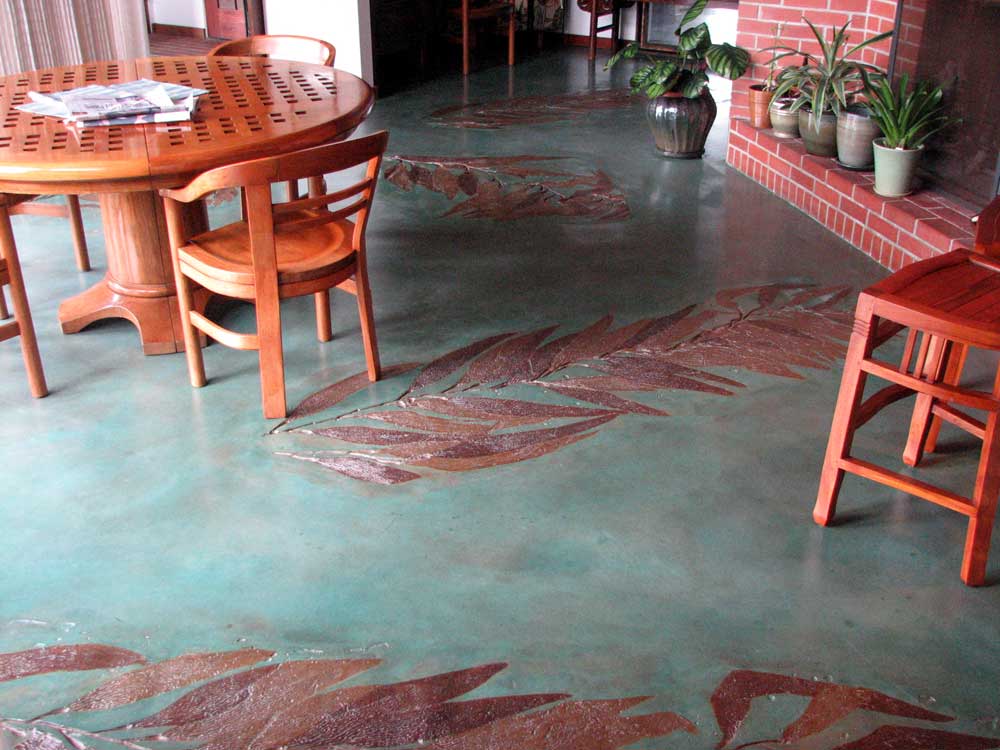 Tom Ralston: My favorite aspect of using natural materials like seaweed is that it's so unique, it's so different. It's such a wonderful way to express concrete in an artistic way. Not a lot of people know this but, Pablo Picasso was a huge lover of concrete and made sculptures out of concrete. Antoni Gaudi from Spain is another that used concrete and stucco as an artistic medium. Thomas Edison made concrete pianos, and concrete cabinetry, and wanted to mass produce concrete houses so that he could have houses that were like Henry Ford's cars, houses that were mass produced - but it didn't work out. Again, coming back to the question, my favorite aspect is that you can create concrete jobs that both last forever and are very unique and very artful. The Chinese Memorial Gate that we did at the Evergreen Cemetery is an example of using concrete as a medium to express not only art, but cultural and historical significance. That project was a wonderful way to use concrete to accomplish all three of those things.
Tom Ralston: My favorite aspect of using natural materials like seaweed is that it's so unique, it's so different. It's such a wonderful way to express concrete in an artistic way. Not a lot of people know this but, Pablo Picasso was a huge lover of concrete and made sculptures out of concrete. Antoni Gaudi from Spain is another that used concrete and stucco as an artistic medium. Thomas Edison made concrete pianos, and concrete cabinetry, and wanted to mass produce concrete houses so that he could have houses that were like Henry Ford's cars, houses that were mass produced - but it didn't work out. Again, coming back to the question, my favorite aspect is that you can create concrete jobs that both last forever and are very unique and very artful. The Chinese Memorial Gate that we did at the Evergreen Cemetery is an example of using concrete as a medium to express not only art, but cultural and historical significance. That project was a wonderful way to use concrete to accomplish all three of those things.
What is the cost benefit of using seaweed or other natural materials in concrete?
Tom Ralston: I don't think there is a cost-benefit. I think that when you start incorporating art like this into concrete, the costs rise. So there's no real cost-benefit of using seaweed or other natural materials in concrete, unless there's a situation where someone wants very expensive stone imported from Italy, but instead they opt to use a really nice decorative concrete that actually is less money. Some of the stone from Greece and Europe, England, Italy, France - they have some outlets and vendors that use real cobblestone from the streets of Europe. I mean that's hugely expensive, so you could compete with that kind of product using an artistic decorative concrete. But for the most part, these kind of artistic applications are not cost beneficial.
What are the most common applications for seaweed or other natural materials in decorative concrete?
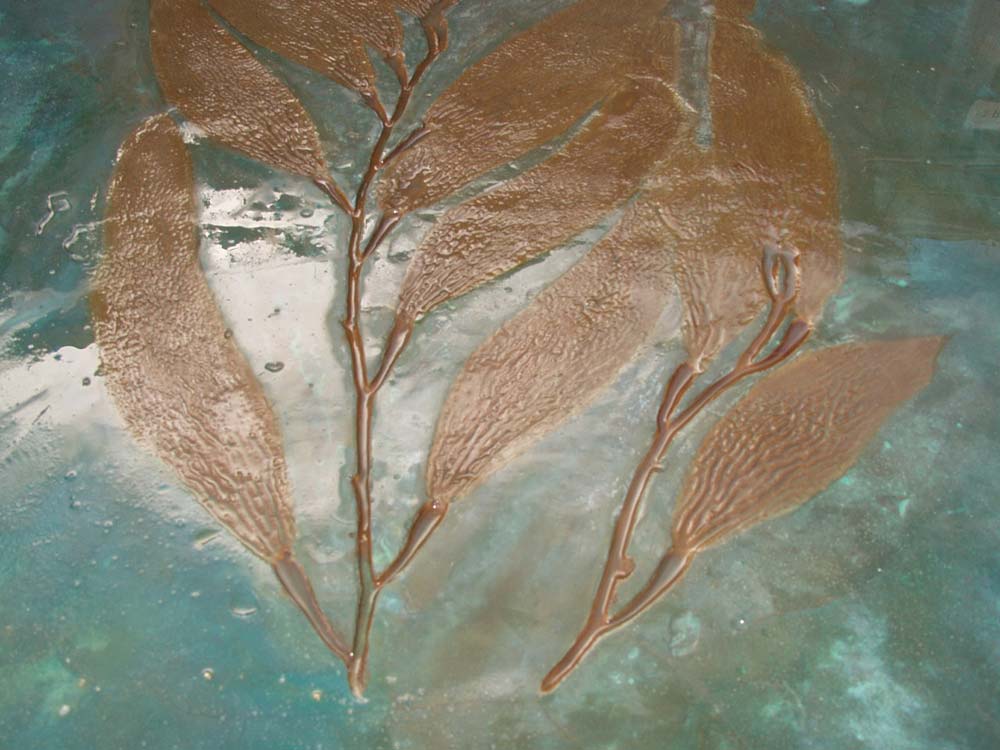 Tom Ralston: I don't think there's a common application for any of those, there's unique applications. They are called out randomly, there's no formula for using them over and over. We are going to be making arrows for a roundabout at the Santa Cruz Wharf, and we are going to be using fish instead of those commonplace arrows that are usually painted on, and are boring as can be. You see so many of those roundabouts in Europe, but they just have little arrows to point the direction. We're going to be casting fish and schools of dolphin that will all be floating and pointing in one direction. That is a great application for utility and art, but it's not cheap. Nonetheless, it is a great way to apply art and concrete for a utility purpose, such as a roundabout.
Tom Ralston: I don't think there's a common application for any of those, there's unique applications. They are called out randomly, there's no formula for using them over and over. We are going to be making arrows for a roundabout at the Santa Cruz Wharf, and we are going to be using fish instead of those commonplace arrows that are usually painted on, and are boring as can be. You see so many of those roundabouts in Europe, but they just have little arrows to point the direction. We're going to be casting fish and schools of dolphin that will all be floating and pointing in one direction. That is a great application for utility and art, but it's not cheap. Nonetheless, it is a great way to apply art and concrete for a utility purpose, such as a roundabout.
Alright folks, that's it for this edition of Decorative Concrete Master Q&A, join us next time for more insider knowledge from decorative concrete master Tom Ralston. We post these Master Q&A's on the first and third thursdays of each month.
Did you enjoy this edition of Decorative Concrete Master Q&A? Submit your own question here, or check out one of Tom's renowned decorative concrete books. Also, we'd love it if you'd come over and say hello on one of our social sites. Follow us or like us for more expert decorative concrete knowledge on Houzz, LinkedIn, Facebook or Instagram.
- Details
- Written by: Tom Ralston
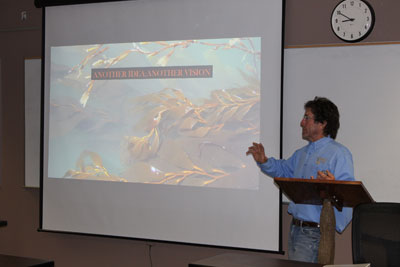 The Concrete Industry Management Program at Chico State University is the only program in the Western United States that combines the academic disciplines of concrete science with business management. I was asked by Program Director Tanya Komas to speak on a topic related to the decorative concrete industry. On May 5, 2014 I gave a lecture on Concrete basics, inspiration and specialty concrete applications. Great time!!
The Concrete Industry Management Program at Chico State University is the only program in the Western United States that combines the academic disciplines of concrete science with business management. I was asked by Program Director Tanya Komas to speak on a topic related to the decorative concrete industry. On May 5, 2014 I gave a lecture on Concrete basics, inspiration and specialty concrete applications. Great time!!
- Details
- Written by: Tom Ralston
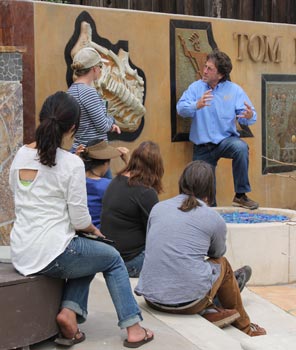 I have been reflecting lately about teaching seminars for decorative concrete. I started doing seminars for Granite Rock at the show grounds in Watsonville California. The Granite Rock demonstration focused on how to color, stamp and texture decorative concrete. This was in 1995.
I have been reflecting lately about teaching seminars for decorative concrete. I started doing seminars for Granite Rock at the show grounds in Watsonville California. The Granite Rock demonstration focused on how to color, stamp and texture decorative concrete. This was in 1995.
I remember a few years later I was asked to do a bonifide seminar by the American Society of Concrete Contractors in Dallas Texas. For the first time I had to speak on a podium and then go out in the field and give a demonstration. This particular seminar was on techniques for Acid Staining Concrete and decorative saw cutting. As I watched another person give his talk I became more and more nervous looking out to the audience of approximately 50-people as I watched another person give his talk. I was supposed to do my presentation at 10:30 a.m. but the speaker before me was running over by about 40 minutes. Because of this run over on time my presentation was pushed to after lunch.
As I sat waiting for my lunch to arrive my nervousness turned to anxiety. When the food showed up I couldn’t eat a thing, in fact I was actually fake eating so that people wouldn’t think there was something wrong. (I might have asked where was the hungry dog under the table was at that moment). When it was my turn to speak the nervousness lasted about 5-minutes. I even had a “quasi-heckler” in the audience and I was able to handle him fairly well. That was over 19 years ago. I’ve been teaching seminars for years.
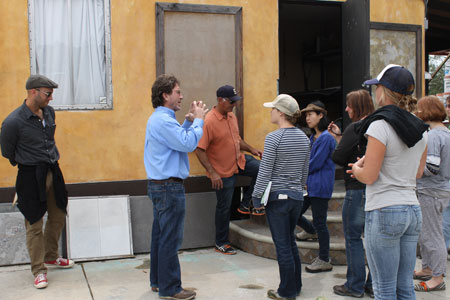 Why do I love teaching seminars?
Why do I love teaching seminars?
I do love teaching and sharing information. Having people that quest for knowledge like I do is exiting. It is a mutual passion and both student and teacher can feed off each other. I love sharing about my trials and tribulations in the world of decorative concrete and hope that my information is of value. I do think I am sharing valuable information. I have made so many costly errors in every aspect of construction and try express that in my seminars and lectures. Knowing that I’ve helped someone see the art in concrete work is so rewarding to me.
Concrete is so versatile. I don’t think a lot of people see that. Hopefully my seminars and lectures will help them realize that they have a greater scope of what concrete can do to beautify a landscape, a hillside, a property, a commercial building. They could even add a glow with a Lumi Lumi Concrete applications.
The real joy comes when I see someone that attended one of my seminars and they have done something really cool with what they learned. Or they come up to me and say they still remember my seminar and how it made a lasting impression on them. I am proud and honored that I could be an inspiration to them.
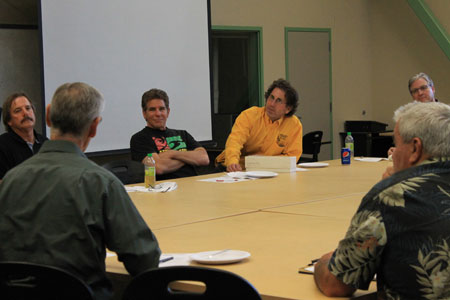 I will be teaching about my experiences for many years to come. The rewards are countless and it is a lot of fun to see my students enjoy themselves.
I will be teaching about my experiences for many years to come. The rewards are countless and it is a lot of fun to see my students enjoy themselves.
I also am on the Board for the Construction Energy and Management course taught at Cabrillo College and have been for seven years. Chuck Mornard is the Chairperson. This helps students find employment in the broad spectrum of opportunities available in the construction industry. The program also provides continuing education for those already employed in the construction industry.
- Details
- Written by: Tom Ralston
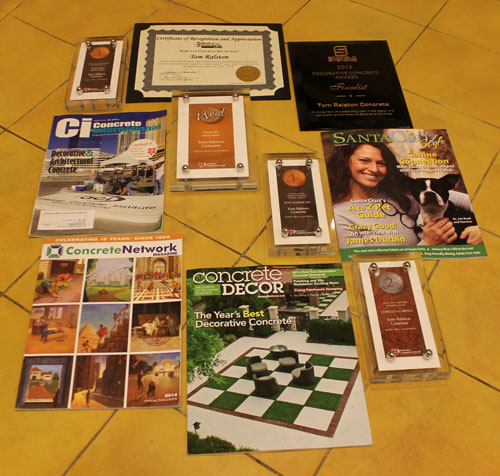 TRC was overjoyed in January @ the 2014 World of Concrete where we received a Certificate of Recognition for presenting 19-Seminars over the last 10-years at the World of Concrete and additionally was presented with 5-Awards with 1-Best of Show out of 96 National Entries; to top it off in February 2014, TRC was featured in 4-Magazines: 1- Local; 2-National and 1-International.
TRC was overjoyed in January @ the 2014 World of Concrete where we received a Certificate of Recognition for presenting 19-Seminars over the last 10-years at the World of Concrete and additionally was presented with 5-Awards with 1-Best of Show out of 96 National Entries; to top it off in February 2014, TRC was featured in 4-Magazines: 1- Local; 2-National and 1-International.
Confucius say:
"While sometimes it is good to sip, at other times it is Great to Guzzle"

